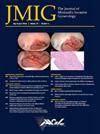The Beginning of a Paradigm Shift: Increase in Perioperative Complications Following Vaginal Hysterectomy Compared to Laparoscopic Hysterectomy Using the ACS-NSQIP 2016 to 2019 Database
IF 3.3
2区 医学
Q1 OBSTETRICS & GYNECOLOGY
引用次数: 0
Abstract
Study Objective
This study aimed to compare the perioperative outcomes of laparoscopic hysterectomy (LH) and vaginal hysterectomy (VH) between 2016 and 2019.
Design
A retrospective cohort study.
Setting
National database study.
Patients
The American College of Surgeons National Surgical Quality Improvement Program (ACS-NSQIP) database was used to identify patients who underwent elective LH or VH between 2016 and 2019.
Interventions
Our primary outcome of interest was a composite incidence of perioperative complications. We generated a propensity score using a multiple logistic regression model to adjust for confounding factors and to reduce the selection bias between the 2 groups. We matched patients who underwent elective LH to patients who underwent elective VH on the logit of the propensity score.
Measurements and Main Results
Of the 76 706 women in the cohort (2016–2019), 62 124 (80.9%) underwent LH and 14 582 (19.0%) underwent VH. After propensity matching (n = 8991 per group), the results of the matched cohort revealed significant differences in the primary composite outcome. The composite risk of death, complications, reoperation, and readmission was lower among patients who underwent LH than among those who underwent VH, such that the primary composite outcome occurred in 5.62% of LH patients compared to 6.65% of VH patients (relative risk [RR] 0.845, 95% confidence interval (CI) 0.753–0.947, p = .004). In addition, the risk of both transfusion and readmission was higher among patients who underwent VH than among those who underwent LH (transfusion: RR 1.372, 95% CI 1.078–1.745, p = .010; readmission: RR 1.546, 95% CI 1.216–1.966, p = .001).
Conclusion
We have found that there is a lower 30-day composite morbidity for patients when undergoing LH compared to VH. These data demonstrate a higher risk of perioperative complications in women undergoing VH and should further inform a surgeon's surgical considerations when deciding the optimal route of hysterectomy, depending on the expertise of the surgeon.
范式转变的开始:阴道子宫切除术与腹腔镜子宫切除术围手术期并发症的增加使用ACS-NSQIP 2016 - 2019数据库
研究目的:在本研究中,我们比较了2016年至2019年腹腔镜子宫切除术(LH)和阴道子宫切除术(VH)的围手术期结果。研究设计:回顾性队列研究。研究设置:国家数据库研究。患者:美国外科医师学会国家手术质量改进计划(ACS - NSQIP)数据库,以确定2016年至2019年期间接受选择性LH或VH的患者。干预措施:我们关注的主要结局是围手术期并发症的综合发生率。我们使用多元逻辑回归模型生成倾向得分,以调整混杂因素并减少两组之间的选择偏差。我们将选择性LH患者与选择性VH患者在倾向评分的logit上进行匹配。测量和主要结果:在队列(2016-2019)的76,706名女性中,62,124名(80.9%)接受了LH治疗,14,582名(19.0%)接受了VH治疗。倾向匹配后(每组n=8,991),匹配队列的结果显示主要综合结局存在显著差异。LH患者的死亡、并发症、再手术和再入院的综合风险低于VH患者,因此主要综合结局发生在5.62%的LH患者和6.65%的VH患者中(相对危险度(RR) 0.845, 95%可信区间(CI) 0.753 - 0.947, p = 0.004)。此外,与LH相比,VH患者输血和再入院的风险更高(输血:RR 1.372, 95% CI 1.078 - 1.745, p =0.010;再入院:RR 1.546, 95% CI 1.216 ~ 1.966, p = 0.001)。结论:我们发现,与VH相比,LH患者的30天综合发病率较低。这些数据表明,接受子宫内膜切除术的妇女围手术期并发症的风险更高,应进一步告知外科医生在决定子宫切除术的最佳途径时的手术考虑,取决于外科医生的专业知识。
本文章由计算机程序翻译,如有差异,请以英文原文为准。
求助全文
约1分钟内获得全文
求助全文
来源期刊
CiteScore
5.00
自引率
7.30%
发文量
272
审稿时长
37 days
期刊介绍:
The Journal of Minimally Invasive Gynecology, formerly titled The Journal of the American Association of Gynecologic Laparoscopists, is an international clinical forum for the exchange and dissemination of ideas, findings and techniques relevant to gynecologic endoscopy and other minimally invasive procedures. The Journal, which presents research, clinical opinions and case reports from the brightest minds in gynecologic surgery, is an authoritative source informing practicing physicians of the latest, cutting-edge developments occurring in this emerging field.

 求助内容:
求助内容: 应助结果提醒方式:
应助结果提醒方式:


